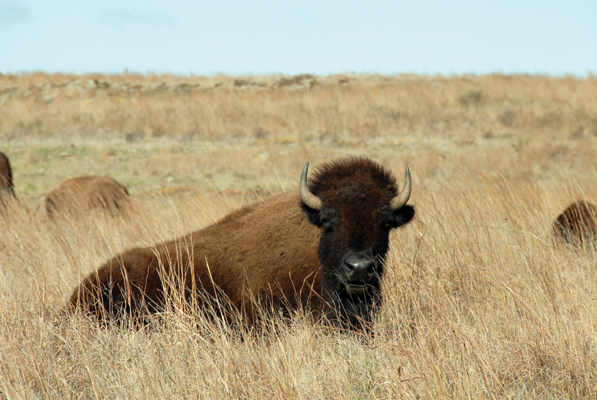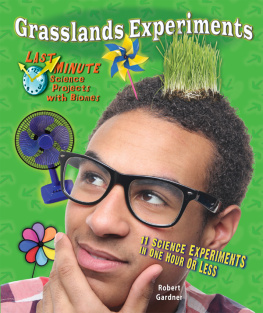Science Projects, Just in Time!
Have you waited until the last minute to start your science project? Dont worry, award-winning author Robert Gardner has you covered! Most of these experiments about the grasslands biome can be done in an hour or less. There are also longer experiments for the budding scientist, and ideas for science fair projects, in case you have more time!
This creative series tackles science concepts that are important for students to learn in a simplified and meaningful way.
Helen Hess, PhD, Series Science Consultant
Professor of Biology
College of the Atlantic
Bar Harbor, Maine
About The Author
Robert Gardner is an award-winning author of science books for young people. He is a retired high school teacher of physics, chemistry, and physical science. In 2010, he received the Lifetime Achievement Award in Hands-On Science Writing from AAAS/Subaru Science Books & Films.

Do you have a science project that is due soon, maybe tomorrow? Then this book is for you! It is filled with experiments about grassland biomes. Most of the experiments can be done in less than one hour. An estimate of the time needed is given for each experiment. But perhaps you have plenty of time to prepare for your next science project or science fair. You can still use and enjoy this book.
Many experiments are followed by a Keep Exploring section. There you will find ideas for more science projects. The details are left to you, the young scientist. You can design and carry out your own experiments, under adult supervision, when you have more time.
For some experiments, you may need a partner to help you. Work with someone who likes to do experiments as much as you do. Then you will both enjoy what you are doing. In this book, if any safety issue or danger is involved in doing an experiment, you will be warned. In some cases you will be asked to work with an adult. Please do so. Dont take any chances that could lead to an injury.
A biome is a region of the earth with a particular climate. The plants and animals that live in a biome are quite similar all around the world. This book is about grassland biomes. But there are other biomes. Earths land biomes include deserts, tundra, taiga, grasslands, rain forests, and temperate forests.
There are 10,000 different species, or types, of natural grass. There are also grasses that are grown to feed humans and other animals. Grasses grown for food include wheat, oats, barley, corn, and rice.
Temperate grasslands get between 10 and 30 inches of rain a year. This is more rain than a desert but less than a temperate forest. Tropical grasslands, or savannas, are warmer grasslands. They need more water. They require 24 to 59 inches of rain each year.
In the United States, there are grasslands (prairies) from the Mississippi River to the Rocky Mountains and south from central Canada to the Gulf of Mexico. Moving west, the prairie grass gradually shortens. It starts at three to ten feet and becomes as short as five to twelve inches near the Rockies. When the soil is deep and rich, and rainfall is plentiful, the grass grows taller. The eastern tall grass grows on deep, rich soil that receives 24 to 30 inches of rain each year. The short grass growing on the semiarid, shallow western soil receives only 10 to 16 inches of rain per year.

Image Credits: Shutterstock.com: dvande
Bison are a native grassland animal.
Before white settlers turned much of the prairie into farms and ranches, Native Americans roamed the biome. Bison grazed on the prairie grass. The animals provided these people with most of their needs. Bison skins clothed their bodies and covered their tepees. The bison provided meat for nourishment. Bison bones were used to make tools. Wood was scarce on the grassland. Dried bison dung was gathered and used as fuel for fires.
During the 1800s, white hunters killed most of the bison, but a few small herds still remain. Today, cattle and sheep are the main grazers on this grassland. The major wild predator is the coyote. Coyotes have replaced wolves. Until recently, wolves had been hunted to near extinction. Other animals that can be found on the prairie include jackrabbits, prairie dogs, ground squirrels, pronghorn antelope, mule deer, rattlesnakes, a variety of birds, and other animals.
During the 1920s, tractors were used to plow the prairie sod. Much of the buffalo grass, grama grass, bluestem, and other grasses were replaced with wheat, corn, cotton, and oilseed crops such as canola and sunflower.

Image Credits: Tom Reichner
Prairie dogs live in grasslands.

Image Credits: StockLite
This field of canola is in bloom with yellow flowers. Canola grass is an important crop. Canola oil is made from canola seeds.
In the 1930s, a long drought dried the soil that farmers had plowed. Strong winds, a common feature of North American grasslands, lifted the soil and carried it in thick clouds of dust. The dust clouds blew eastward across the country. The western dust could even be detected by ships on the Atlantic Ocean. A large section of the grasslands became known as the dust bowl. Many farmers whose soil was blown away abandoned their farms and moved to California.
Grasslands can be found all around the world. Grasslands have different names in other continents. What we call grassland or prairie is known as steppes in Eurasia and Asia, pampas in Argentina, and veldt in South Africa.
To do experiments the way scientists do, you need to know about the scientific method. It is true that scientists in different areas of science use different ways of experimenting. Depending on the problem, one method is likely to be better than another.
Despite these differences, all scientists use a similar approach as they experiment. It is called the scientific method. In most experimenting, some or all of the following steps are used: making an observation, coming up with a question, creating a hypothesis (a possible answer to the question) and a prediction (an if-then statement), designing and conducting an experiment, analyzing results, drawing conclusions about the prediction, and deciding if the hypothesis is true or false. Scientists share the results of their experiments by writing articles that are published in science journals.
You might wonder, How do I use the scientific method? You begin when you see, read, or hear about something in the world that makes you curious. So you ask a question. To find an answer, you do a well-designed investigation; you use the scientific method.
Once you have a question, you can make a hypothesis. Your hypothesis is a possible answer to the question (what you think is true). For example, you might hypothesize that rainfall in a grassland is less than it is in a temperate forest. Once you have a hypothesis, it is time to design an experiment to test your hypothesis.
In most cases, you should do a controlled experiment. This means having two subjects that are treated the same except for the one thing being tested. That thing is called a variable. For example, to test the hypothesis above, you might measure the annual rainfall in a grassland and in a temperate forest over a decade. If you found that the rainfall in the grassland was significantly less than in the forest, you might conclude that your hypothesis was correct.






















